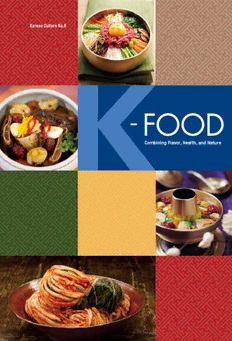
K-FOOD: Combining Flavor, Health, and Nature PDF
Preview K-FOOD: Combining Flavor, Health, and Nature
Korean Culture No.9 FOOD Combining Flavor, Health, and Nature About the series The Korean Culture series is one of the Korean Culture and Information Service’s projects to furnish international readers with insights into and basic understanding of the dynamic and diverse aspects of contemporary Korean culture. FOOD Korean Culture No.9 K-FOOD: Combining Flavor, Health, and Nature Copyright © 2015 by Korean Culture and Information Service. All Rights Reserved. No part of this book may be reproduced or utilized in any form or by any means without the written permission of the publisher. First Published in 2013 by Korean Culture and Information Service Ministry of Culture, Sports and Tourism Phone: 82-44-203-3334~51 Fax: 82-44-203-3595 Website: www.kocis.go.kr ISBN: 978-89-7375-599-8 04680 ISBN: 978-89-7375-596-7 04680 (set) For further information about Korea, please visit: www.korea.net Combining Flavor FOOD Health Nature Contents 10 Prologue 14 Chapter One K-Food in the World 15 K-Food: A New Global Food Trend 34 Non-Koreans Share Korean Cuisine with the World 44 Fine Dining Korean Restaurants Around the World and Star Korean Chefs 52 Chapter Two K-Food, a Harmony of Taste, Health, and Nature 53 Nutritional Balance in the Korean Diet 73 Nutritional Value and Health Benefits of Korean Ingredients 84 Leading Ingredients, Seasonings, and Cooking Techniques 94 Chapter Three Nine of the Most Popular K-Foods 95 Kimchi (baek-kimchi, Kimchi-bokkeum-bap, kimchi-Jeon) 104 Bibimbap: Mixed Rice with Meat and Assorted Vegetables 108 Bulgogi: Marinated Meat Cooked on the Grill 112 Bossam: Napa Wraps with Pork 114 Japchae: Stir-fried Glass Noodles and Vegetables 117 Haemul-PaJeon: Seafood and Green Onion Pancake 120 Makgeolli: Korean Traditional Rice Wine 124 Samgye-tang: Ginseng Chicken Soup 130 Tteok-bokki (Gungjung-Tteok-bokki) 136 Chapter Four Six Easy Tips for Korean Cooking 137 Tip 1. Kimchi-based Dishes 139 Tip 2. Creations with Korean Flavors 141 Tip 3. Bulgogi Seasoning and Various Meat Dishes 142 Tip 4. Korean Dishes for K-pop Parties 144 Tip 5. Korean Soybean Dishes for Vegetarians 145 Tip 6. Side Dishes - Not spicy, Healthy and Easy! 151 Epilogue 154 Appendix 8 K-FOOD: Combining Flavor, Health, and Nature “The noted Chicago eatery Blackbird has kimchi on the menu, and California Pizza Kitchen is developing Bulgogi(Korean barbecue) beef pizza. In Los Angeles, crowds are lining up for street food from a pair of Korean taco trucks called Kogi. ... Redolent with garlic, sesame oil and red chili peppers, Korean food is suddenly everywhere.” Juliet Chung, Wall Street Journal, March 7, 2009 “There is no shortage of top-quality Korean ingredients – fish, shellfish, marbled beef – and there is great affection for kimchi, a condiment of fermented cabbage, radishes, chilli, fish sauce, garlic, and ginger. … Korean food—spicy, quickly prepared and served—also lends itself to the informal style of restaurant that has seen Wagamama, Busaba Eathai, and Ping Pong in London, as well as Momofoku in New York, achieve such success.” Nicholas Lander, Financial Times, January 21, 2011 “Salt Lake City’s food scene is in for a healthy jolt. Korean food is a hot ethnic dining trend on the west and east coasts and is seeping into mainstream restaurants in Utah.” Glen Warchol, The Salt Lake Tribune, Jan 05, 2012 K-Food in the World 9 Prologue A wide variety of plates and bowls are used to set a table with Hansik, or Korean food. Bap (cooked rice), and a bowl of soup made from either meat and vegetables or fish, are set in front of the diner. A large pot or bowl of stew is placed at the center of the table, while various banchan (side dishes) are neatly arranged on the table. All of these dishes are set together, and the harmony created by the vegetable dishes and meat dishes seasoned with fermented sauces which have been made over a long period of time with care, is what makes Hansik uniquely Korean. Despite this uniqueness and the variety of food that is offered, the only Korean foods that were familiar to non-Koreans were the simple Bulgogi or “Korean barbeque.” However, things have changed in recent years, and Korean food is now being recognized as a source for new and exciting culinary dishes. The reason for this is simple. People today are becoming increasingly conscious about their health, and the food that is offered is being tailored to suit these needs. Many are looking for organic or natural foods, “slow foods” and food that will help their overall well-being, and Korean cuisine meets all those requirements. Moreover, it is tasty. When asked about how they were introduced to Korean cuisine, non-Koreans responded that it piqued their interest because it was something new and it was unique, but they later fell in love with it because it was healthy and delicious. World- renowned chefs have also been mesmerized by the kimchi- making process, with its generous amount of garlic, 10 K-FOOD: Combining Flavor, Health, and Nature
